Great choice! Your favorites are temporarily saved for this session. Sign in to save them permanently, access them on any device, and receive relevant alerts.
- Sailboat Guide

Venture 2-24
Venture 2-24 is a 24 ′ 6 ″ / 7.5 m monohull sailboat designed by Roger MacGregor and built by Macgregor Yacht Corp between 1971 and 1974.
Rig and Sails
Auxilary power, accomodations, calculations.
The theoretical maximum speed that a displacement hull can move efficiently through the water is determined by it's waterline length and displacement. It may be unable to reach this speed if the boat is underpowered or heavily loaded, though it may exceed this speed given enough power. Read more.
Classic hull speed formula:
Hull Speed = 1.34 x √LWL
Max Speed/Length ratio = 8.26 ÷ Displacement/Length ratio .311 Hull Speed = Max Speed/Length ratio x √LWL
Sail Area / Displacement Ratio
A measure of the power of the sails relative to the weight of the boat. The higher the number, the higher the performance, but the harder the boat will be to handle. This ratio is a "non-dimensional" value that facilitates comparisons between boats of different types and sizes. Read more.
SA/D = SA ÷ (D ÷ 64) 2/3
- SA : Sail area in square feet, derived by adding the mainsail area to 100% of the foretriangle area (the lateral area above the deck between the mast and the forestay).
- D : Displacement in pounds.
Ballast / Displacement Ratio
A measure of the stability of a boat's hull that suggests how well a monohull will stand up to its sails. The ballast displacement ratio indicates how much of the weight of a boat is placed for maximum stability against capsizing and is an indicator of stiffness and resistance to capsize.
Ballast / Displacement * 100
Displacement / Length Ratio
A measure of the weight of the boat relative to it's length at the waterline. The higher a boat’s D/L ratio, the more easily it will carry a load and the more comfortable its motion will be. The lower a boat's ratio is, the less power it takes to drive the boat to its nominal hull speed or beyond. Read more.
D/L = (D ÷ 2240) ÷ (0.01 x LWL)³
- D: Displacement of the boat in pounds.
- LWL: Waterline length in feet
Comfort Ratio
This ratio assess how quickly and abruptly a boat’s hull reacts to waves in a significant seaway, these being the elements of a boat’s motion most likely to cause seasickness. Read more.
Comfort ratio = D ÷ (.65 x (.7 LWL + .3 LOA) x Beam 1.33 )
- D: Displacement of the boat in pounds
- LOA: Length overall in feet
- Beam: Width of boat at the widest point in feet
Capsize Screening Formula
This formula attempts to indicate whether a given boat might be too wide and light to readily right itself after being overturned in extreme conditions. Read more.
CSV = Beam ÷ ³√(D / 64)
‘Pop Top’ model though otherwise similar to VENTURE 24.
Embed this page on your own website by copying and pasting this code.
- About Sailboat Guide
©2024 Sea Time Tech, LLC
This site is protected by reCAPTCHA and the Google Privacy Policy and Terms of Service apply.

MacGregorSailors.com
Discussions relating to the MacGregor line of trailerable sailboats
Skip to content

- Main Site Board index MacGregorSailors Forums MacGregor/Venture Discussion
1974 Venture 2-24
Post by Silent Partner » Thu Nov 29, 2012 4:16 am
Re: 1974 Venture 2-24
Post by bmxer » Thu Nov 29, 2012 4:47 am
Post by Silent Partner » Thu Nov 29, 2012 8:51 pm
Post by voltzwgn » Thu Nov 29, 2012 9:19 pm
Post by Silent Partner » Fri Nov 30, 2012 12:37 am
Post by topcat0399 » Fri Nov 30, 2012 1:33 am
Post by Silent Partner » Fri Nov 30, 2012 2:12 am
Post by Bob McLellan » Fri Nov 30, 2012 2:47 am
Post by topcat0399 » Fri Nov 30, 2012 3:02 am
Post by topcat0399 » Fri Nov 30, 2012 3:32 am
Silent Partner wrote: Hi topcat My plan is to learn how to sail her. In 2014, I intend to join in the Wednesday night races. (I use to be on the race committee boat.) Yes, she's in pretty good shape. Muscles or something up around the top of the keel, but it's too cold to go clean her now.
Post by Silent Partner » Fri Nov 30, 2012 3:46 am
Post by heinzir » Fri Nov 30, 2012 5:48 am
Post by Silent Partner » Sat Dec 01, 2012 9:10 pm
Return to “MacGregor/Venture Discussion”
- MacGregorSailors Forums
- ↳ Website News & Announcements
- ↳ MacGregor Powersailor Discussion
- ↳ MacGregor/Venture Discussion
- ↳ Performance & Tuning
- ↳ Trailers & Towing
- ↳ Repairs and Modifications
- ↳ Destinations, Clubs, Events and Venues
- ↳ Trip Logs
- TattooSailors Forums
- ↳ Tattoo Yachts Discussion
- Special Interest Forums
- ↳ Australia Group
- ↳ Canada Group
- ↳ European Group
- ↳ Rest of the World
- ↳ Admiral's Galley
- ↳ The Front Room
- Main Site Board index
- All times are UTC+01:00
Powered by phpBB ® Forum Software © phpBB Limited
Privacy | Terms

- Forum Listing
- Marketplace
- Advanced Search
- All Topics Sailing
- General Sailing Discussions
- SailNet is a forum community dedicated to Sailing enthusiasts. Come join the discussion about sailing, modifications, classifieds, troubleshooting, repairs, reviews, maintenance, and more!
Mac-Venture 2-24
- Add to quote
cdang10- Check out this link: MacGregorSailors.com • View forum - MacGregor/Venture Discussion You have picked up, arguably, the most common starter boat ever introduced to the market. You will be able to find parts and pieces for this boat almost anywhere. There is a very acitve group in almost every boating community for support and comiserating....(dont worry, we all do it).
Realizing my post could be misconstrued as negative...I should elaborate. By "common", I meant Macgregor has probably introduced more people to sailing than many other manufactures combined. They built cost conscious boats aimed at the novice to intermediate sailor who wants to get out on the water with minimal cash outlay. In general, they are a perfect platform to get out and enjoy sailing..... ....fair winds to ya...
Thank you MSter! You led me to the perfect place.
2-24 fan I owned a 2-24 and logged thousands of miles in it. It is a very light displacement boat and is rigged accordingly. It is very easy to single hand and it has just enough sail handling equipment to be a great starter boat for somebody who would eventually like to move up. I loved mine and my wife cried both times I sold it (she made me buy it back the first time). There is almost nothing proprietary on the boat so you should be able to restore and maintaine it very easily. The under water profile (except the rudder and keel, which are easily modified) is ideal for surfing and it was not uncommon to have sustained speeds of 10 to 12 knots on the way to Catalina from MDR. However, that thing has no business in the open ocean and I would discourage going off-shore in it....unless you like white knuckle rides.
Just want to use this along the coast of Maine. I am truly a beginner - have never been under sail on the ocean. Have a 15' Precision but have only been on lakes. I'm looking forward to learning about this boat while I restore it.
Venture 2-24 I have a 1972 Venture 2-24 and sail it in coastal Maine waters. Tender, forgiving and will get you back to the mooring if well maintained. I up-graded the rudder with one from Ida and some other odds and ends to make solo sailing much more of a "snap". I put two marine batteries under the foward seat which made a day/night difference (as well as the Ida rudder which is HIGHLY recommended!!) Sailed her off the mooring for three years and it's been great. 2009 got nailed Memorial Day by a squall packing 60+ mph winds; tough day, but made it back to the mooring. Maintenance counts on days like that! I now run a Tartan 27; another of the "good ol' boats"
Attachments

In case you are not already aware of it, there is an excellent Venture 24 specific web site and forum at Venture24 : Venture 24 sailboats
- ?
- 176.2K members
Top Contributors this Month
- New Sailboats
- Sailboats 21-30ft
- Sailboats 31-35ft
- Sailboats 36-40ft
- Sailboats Over 40ft
- Sailboats Under 21feet
- used_sailboats
- Apps and Computer Programs
- Communications
- Fishfinders
- Handheld Electronics
- Plotters MFDS Rradar
- Wind, Speed & Depth Instruments
- Anchoring Mooring
- Running Rigging
- Sails Canvas
- Standing Rigging
- Diesel Engines
- Off Grid Energy
- Cleaning Waxing
- DIY Projects
- Repair, Tools & Materials
- Spare Parts
- Tools & Gadgets
- Cabin Comfort
- Ventilation
- Footwear Apparel
- Foul Weather Gear
- Mailport & PS Advisor
- Inside Practical Sailor Blog
- Activate My Web Access
- Reset Password
- Customer Service

- Free Newsletter

Ericson 41 Used Boat Review

Mason 33 Used Boat Review

Beneteau 311, Catalina 310 and Hunter 326 Used Boat Comparison

Maine Cat 41 Used Boat Review

Tips From A First “Sail” on the ICW

Tillerpilot Tips and Safety Cautions

Best Crimpers and Strippers for Fixing Marine Electrical Connectors

Thinking Through a Solar Power Installation

Polyester vs. Nylon Rode

Getting the Most Out of Older Sails

How (Not) to Tie Your Boat to a Dock

Stopping Mainsheet Twist

Fuel Lift Pump: Easy DIY Diesel Fuel System Diagnostic and Repair

Ensuring Safe Shorepower

Sinking? Check Your Stuffing Box

The Rain Catcher’s Guide

What Do You Do With Old Fiberglass Boats?

Boat Repairs for the Technically Illiterate

Boat Maintenance for the Technically Illiterate: Part 1

Whats the Best Way to Restore Clear Plastic Windows?

Giving Bugs the Big Goodbye

Galley Gadgets for the Cruising Sailor

Those Extras you Don’t Need But Love to Have

What’s the Best Sunscreen?

UV Clothing: Is It Worth the Hype?

Preparing Yourself for Solo Sailing

How to Select Crew for a Passage or Delivery

R. Tucker Thompson Tall Ship Youth Voyage


On Watch: This 60-Year-Old Hinckley Pilot 35 is Also a Working…

On Watch: America’s Cup

On Watch: All Eyes on Europe Sail Racing

Dear Readers
- Sailboat Reviews
Venture 21 Used-boat Review
The vintage macgregor is a good example of a budget-friendly boat..
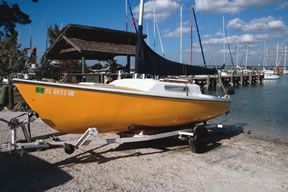
Maybe this has happened to you: You’re on a country road, driving to a wedding (or family vacation or business conference), and you pass a sailboat on a trailer with a “For Sale” sign. It’s not a big boat. It’s not a small boat. But it’s just about right for launching a small adventure with your young family, or maybe you’re looking to downsize. You can’t resist stopping for a closer look. Incredibly, the sign reads “$600,” including a nearly new trailer and an old 4-horsepower, two-stroke outboard that “runs like a top.” You write down the number and drive away, thinking: “Somebody is giving away a perfectly good boat.”
Chances are that “steal of a deal” is a Roger MacGregor-designed Venture 21, and if not, it’s probably one of the many copycats riding the trailer-sailer boom that MacGregor’s little boat ignited. The Catalina 22, the Santana 21, and the San Juan 21 are just some of the boats that followed closely in the wake of the Venture 21’s introduction.
The concept for the Venture 21 came out of MacGregor’s master’s thesis in the Stanford University MBA program. The first hull was introduced in 1965, but full-fledged production didn’t begin until 1967. Several thousand hulls later, the last MacGregor 21 (the boat was renamed in 1980) rolled off the line in 1986 at the MacGregor factory in Costa Mesa, Calif. Today, with some 36,000 sailboat hulls behind it, the company builds just one boat, the hybrid sailboat/powerboat MacGregor 26x.
Although MacGregor sold fewer Venture 21s than its successor—the Venture 22, which later became the pop-top Venture 22-2—the 21’s easy trailerability and affordable price helped it maintain its popularity throughout the 1970s. Capitalizing on the fiberglass revolution in boatbuilding, MacGregor’s business-school project sparked a pivotal marketing shift that helped bring recreational sailing to mainstream America.
While the trailer-sailer boom is far behind us, the Venture 21 and its many look-alikes have renewed relevance today. With their discretionary spending sharply cut, younger sailors are taking the Craigslist-route into sailing, scouring the classified ads for boats that don’t require dock space but still have room for a family sail. Meanwhile, many owners of 30-plus-footers are considering downsizing to a boat that doesn’t require mooring fees and a hefty maintenance bill each spring. For better or for worse, in the dim light of a recession, a back-to-basics giveaway boat on the roadside begins to look awfully enticing. For these and other reasons, PS decided to take a closer look at the Venture 21, which, in many ways, is the epitome of “the boat with a price I couldn’t refuse.”

The Venture 21 was designed to be affordable, easy to trailer and launch, and fun to sail, with enough room below for storing gear, napping, or even spending a night at anchor. It was principally aimed at new sailors, but it also appealed to those who wanted to step up from an open daysailer. Its size, sail area, and hull design were tailored for lakes and bays with fickle breezes of less than 15 knots.
Seaworthiness and performance were important considerations but pragmatism and aesthetic appeal were the driving force behind its design features.
Although the boat’s low headroom and Spartan interior would not qualify it as a weekender today, it was initially marketed as a “cruising” sailboat. A sleep-aboard sailboat that could be hauled around the country behind the family station wagon seemed perfectly in tune with the wanderlust of the 1960s.
While the Venture 21 is regarded as one of the first modern trailer-sailers, no single design element stands out as particularly revolutionary or unique. Instead, MacGregor incorporated proven features that would not only appeal to serious sailors, but also would remain consistent with the public perception of what a good boat should be and look like. In the yacht market, the Cruising Club of America boats were still the aesthetic model. Carl Alberg’s popular Ensign, launched by Pearson in 1962, is a good example of a small boat that clung to the CCA philosophy and aesthetic.
The Venture’s heritage is more closely aligned with two daysailers that were enjoying a surge of popularity on the East Coast in the early 1960s: the 17-foot Day Sailer, designed by George O’Day and Uffa Fox in 1958, and, to a lesser degree, the Phillip Rhodes-designed Rhodes 19, first offered by O’Day in 1959. Both were built by the nascent O’Day Group of Fall River, Mass. The similarities in the three boats are most apparent above the waterline. All have a relatively flat sheer line and spoon-like bow overhang (or spoonbow), elements that predate the modern yachting era.
While the Rhodes 19 still carries fairly deep V-sections well aft, making it a capable performer in the chop typical of its New England home waters, the Day Sailer flattens out, particularly at the stern, giving it fast, near-planing speeds off the wind. Fox and O’Day later refined this feature, earning Fox a reputation as the innovator of the planing dinghy. With a modest V-shape and a relatively fine bow, the Venture 21 lies somewhere between the two Rhodes 19 and the Day Sailer.
The Venture’s swing keel gives it 5 feet, 6 inches of draft—even more than its popular big brother, the Venture 25—and retracts to allow the boat to float in about 15 inches of water. (The brochure says 12 inches.)
Although the original design called for a fractional rig with a 22-foot mast, this was later changed to a masthead rig, giving it quite a bit of horsepower for its era. At the peak of its production in the late 1970s, the Venture 21 enjoyed popularity as a racing boat, with fleets springing up on the Gulf Coast, the Great Lakes, and the Northeast, as well as its home waters of Southern California. Although some owners have gone to the trouble of re-routing running rigging, fairing the keel, adding travelers and vangs, and replacing the pinned turnbuckles with threaded turnbuckles, we’d encourage someone inclined toward performance to look at a more modern hull with an active racing fleet.
One of the most notable features is the boat’s 7-foot cockpit, as big as that found in the much larger and heavier Catalina 22. However, unlike the Catalina 22, the San Juan 21, and the successively longer Ventures (V-22, V-23, V-25) that widened the cabintop to provide more interior space, the Venture 21 preserves enough sidedeck for crew to move forward . . . with care. Many V-21s, like the one we sailed, never had lifelines; others have had their lifelines removed. The standard single lifelines—low and poorly supported by widely spaced stanchions—offer a modicum of safety, but these are still less than ideal. In our view, lifelines are not a deal-breaker on a 21-foot daysailer, but if you have small children, a boat that is equipped with lifelines with a supporting pushpit and pulpit would be preferable.
The cockpit has a small lazarette, presumably to store fuel for the small bracket-mounted outboard, but this leads directly to the bilge, a bad idea that presents a potential fire risk. The original boats came equipped with top-grinding winches with short T-tracks for the jib. The boat we sailed had only a single fixed-point for the jib sheet. The end-of-boom mainsheet has a 4:1 purchase that spreads the load to each corner of the stern, a basic setup that limits trim options. Some owners modified the leads and added a mainsheet traveler, although this entails either raising the traveler over the tiller, or moving the sheet forward on the boom; both are compromise solutions.
A modest 18- by 18-inch fiberglass bow hatch allows ventilation down below, as well as a place for sails to be passed down. There is no anchor locker or chain pipe. The boat we sailed had an 8-inch diameter screw-on PVC deck plate that was apparently used as a chain pipe.
Overall, the deck has a functional layout, fine for its primary mission, which is to enjoy some time on the water with very little hassle.
Accommodations
The biggest drawback to the Venture 21’s emphasis on trailerability and a 1960s aesthetic is the lack of headroom below. By keeping the cabintop and topsides profile low, MacGregor produced a boat that, in our view, is better looking than the slab-sided models that followed. However, the end result is a very cramped interior. The VW-camper-inspired pop-top on the Venture 22-2, which came shortly after the Venture 21, offered a compromise that was adopted by a number of boats in this size range. Gradually, the intrinsic appeal of a low profile gave way to market demands. (MacGregor’s current and only model, the M26x, is a classic example of the wedding cake look that eschews traditional aesthetics for the sake of comfort below.)
With two quarter berths and a V-berth, the Venture 21 technically could sleep four, but this sort of arrangement probably would be brief and acrimonious. Although you could pack a lot of gear under the cockpit, actual locker storage is limited. Some ambitious owners have added sinks, small galleys, 12-volt systems, and port-a-potties below, but the boat’s cramped headroom restricts its suitability for more than a few days of cruising. For the 20-something adventurer with aspirations of camp-cruising on one of America’s many inland lakes, it will do just fine, but more than a couple of days aboard a boat this size will be a sure test of any marriage.
Construction
During the Venture 21’s 15-year production run, from 1965-1980, the materials and construction methods used for its deck, rig, structural components, and keel went through several changes. Construction of the hull itself, however, remained virtually unchanged. The hull was hand laid up with woven roven and mat. The layup schedule was a single unit of alternating mat and woven roven. Owners do report flexing in some spots, although we noted none on the boat we tested. The early boats are fairly resin rich, so hull thickness is not necessarily a reflection of strength.
The earliest Ventures had a stick-built interior, with bulkheads and bunks made of resin-coated cuts of plywood that were laminated in place. These earlier versions make it easier for owners to modify or rebuild an interior, and this is almost an inevitable project, given plywood’s propensity to rot and delaminate.
By the mid-1970s, MacGregor switched to a molded liner, which accelerated production and eliminated issues of rot, but added about 200 pounds to the total weight. Large sections of the boat are enclosed and filled with foam—a touted safety feature—but it is nonsense to consider the boat unsinkable, as some websites and blog posts suggest.
About 50 V-21s featured lead keels. The poured lead was anchored to a steel beam, and the entire construction sheathed in fiberglass. This process was not only expensive, but it also presented significant corrosion problems, as water eventually migrated into the fiberglass-encased keel.
Most models have solid iron keels; corrosion, however, is still a problem with these keels, but they can be removed, ground-down, faired, and sealed with an epoxy barrier coat to provide many more years of service. This is the biggest “problem” with the Venture 21, and any buyer should take a close look at the keel and the related components.
The original deck was plywood core, but this was later changed to balsa. In either case, rot is a potential problem (particularly in areas of the owner-installed deck hardware), but none of the 14 owners of Venture 21s who participated in our survey reported significant problems with deck rot.
The hull-to-deck joint was initially a bolted and adhesive-bonded shoebox joint, in which the lip of the deck flange fits over the hull just like a shoebox lid. This was later modified to an outward turning flange joint, with the hull lip turning outward to present a horizontal bonding surface for the deck. In both cases, the joint was bonded with a polyurethane adhesive sealant such as 3M 5200, bolted together, and then covered with an extruded aluminum and vinyl rubrail. Neither joint is as rugged as an inward-turning flange, but this is method is typical for a boat of this size.
Early versions of the Venture 21 were fractional rigs, but the majority were masthead rigs with overlapping jibs. An off-center backstay and upper and lower shrouds add support to the 22-foot mast. Early boats, like the 1969 model that we test sailed, did not have spreaders on the upper shrouds. In windy areas, where mast pumping is a noticeable problem, retrofitting spreaders—or looking for a more suitable boat—would be a good idea. The chainplates are through-bolted to the hull, eliminating the typically rot-prone attachment to plywood bulkheads found in some larger boats of this vintage. The original turnbuckles are the fixed-adjustment type that allow 1/8-inch adjustment intervals, making it hard to tune the rig at sea, but impossible to over-tighten, a common novice error.
The two biggest problems cited in our owners’ survey were the hand-crank keel winch and the keel-retaining bolt. Although the keel winches on later MacGregor models are braked mechanisms that will not spin freely under load, the one on the Venture 21 is a common ratchet-type trailer winch. If it is let go under load, the handle can whip around dangerously. Many owners have replaced this with a braked winch—a good idea, although these winches will require more maintenance. The keel-retaining bolt is a 3/8-inch diameter bolt that is slipped through a hole in the centerboard trunk and a corresponding hole in the keel. It is used to lock the keel in place when sailing in deep water, preventing the keel from flopping back into the hull should the boat capsize or surf down the face of a wave. The retaining bolts are commonly bent during a grounding, and any boat with a bent one should be inspected closely around the hull and keel trunk for other signs of damage.
Overall, the construction is light, but adequate for the boat’s designed purposes. If the deck isn’t too rotten, and the swing keel and keel box aren’t shot, most any other potential problem on the Venture 21 is easily remedied by someone who is handy and has the time.
Performance
During its heyday, the Venture 21 was promoted for it speed. MacGregor touted its position as the first of the “hot retracting keel boats” and the “fastest of its type,” with “planing speeds at over 16 miles per hour.” In this age of ultra-light monohulls and multihulls with eye-popping sail area (see PS, September 2009 and May 2010), this sort of hype seems quaint, but if you compare the Venture 21 to other boats of its era, it is clearly no slouch (See “Venture 21 in Context,” page 11). Its sail area/displacement ratio puts it ahead of several contenders, and its hull form—as mentioned—does give it an ability to hit double-digit speeds in the right hands.
The boat we test sailed was handicapped by ancient sails and an outboard that could not be fully tilted out of the water. Although the boat had a masthead rig, the headsail was a fractional working jib. A 140-percent genoa, found on many boats, would have added about 25 percent to the total sail area. To windward, the boat tacked smartly through 90 degrees, although we’d expect a boat with good sails to point higher. The boat was initially tender on the wind, but once the full effect of the 400-pound keel exerted its influence, the boat settled into a comfortable heel. Despite the deep bellies in her sails, the boat handled gusts surprisingly well, and by adjusting the swing keel’s depth, testers could easily achieve a balanced helm. Off the wind in 12 to 15 knots of breeze, we were able to sustain speeds of 7 knots under working sails alone with the keel almost fully retracted. While not wind-in-your hair sailing by today’s standards, it meets our definition of fun.
Conclusions
After spending some time aboard the Venture 21, we were reminded how much and how little has changed since the boat was introduced more than 40 years ago. Most comparable modern “weekenders” with big cockpits and modest cabins, like the Precision 21 or Catalina Capris 22, offer much more in terms of safety, systems (limited as they are), and modern conveniences. And entry-level daysailers like the thermo-molded Hunter 216 offer more in terms of performance options, such as a sprit for the asymmetrical sail and rigging conveniences like a hydraulic lifting keel. If true small-boat performance with a potential for one-design racing is what you’re after, then a boat like the J/22 presents a more sensible choice.
While overall construction quality has improved over the past 40 years, most daysailer hulls (the Hunter 216 and the balsa-cored J/22 excepted) are still solid fiberglass and laid up by hand, an economical and forgiving method. Many daysailers with cabins are actually much heavier than the lightly built V-21, but they also have much better finish quality.
The bottom line with the Venture 21 is the bottom line. If you hunt around long enough, you are likely to pick up a sailaway boat with a trailer and outboard for less than $3,000—about the cost of a new trailer. The boat we sailed sold for far less, including the trailer and 4-horsepower Evinrude. If you are really patient, you can probably find a fixer-upper that someone will give to if you promise to drag it off their property.
Is this 40-year-old, mass-produced boat still a viable option for the entry-level sailor, or someone looking to downsize? No question about it. The Venture 21 is not a boat we’d recommend for someone with offshore aspirations or in places like San Francisco Bay where heavy air and a stiff chop would render it wet, slow, and uncomfortable. However, if you plan some coastal or lake adventures and are limited by a 2,000-pound tow capacity and a recession-era budget, then the Venture 21 definitely deserves a look.
There is one key caveat: Because it is easy to underestimate the amount of work required to revive barn-found boat, we would strongly urge looking for a Venture 21 that is in sailaway condition, rather than a project boat. Dealing with the iron keel alone can be a time-consuming project, and despite the boat’s interesting history, this adds little or no to resale value. On the good side, however, should you decide to embark on the restoration of a Venture 21, you will not be alone. Plenty have done it before, and given the boat’s irresistibly low price tag, more will surely follow in their wake.
RELATED ARTICLES MORE FROM AUTHOR
What kind of Trailer did your boat have. Mine (1972) is a 4″ welded C Channel, Is this a factory style trailer or somebody’s back yard built. It has the right v notches for the C/B etc.
LEAVE A REPLY Cancel reply
Log in to leave a comment
Latest Videos
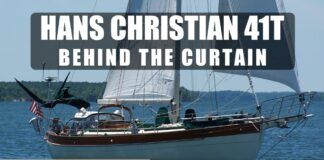
Hans Christian 41T – Boat Review

Seven dead after superyacht sinks off Sicily. Was the crew at...

What’s the Best Sailboats for Beginners?

Why Does A Sailboat Keel Fall Off?
Latest sailboat review.
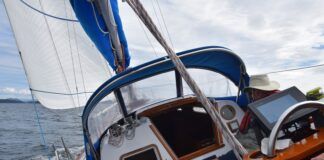
- Privacy Policy
- Do Not Sell My Personal Information
- Online Account Activation
- Privacy Manager
Visit our Popular Forums
- Monohull Sailboats
- Multihull Sailboats
- Powered Boats
- General Sailing
- Antares Yachts
- Fountaine Pajot
- Lagoon Catamarans
Cruising Business
- Boat Classifieds
- General Classifieds
- Crew Positions
- Commercial Posts
- Vendor Spotlight
Life Aboard a Boat
- Provisioning: Food & Drink
- Families, Kids, & Pets Afloat
- Recreation, Entertainment, & Fun
- Boat Ownership & Making a Living
- Liveaboard's Forum
Seamanship, Navigation & Boat Handling
- Seamanship & Boat Handling
- Training, Licensing, & Certification
- Health, Safety, & Related Gear
- Rules of the Road, Regulations, & Red Tape
Engineering & Systems
- Const. / Maint. / Refit
- Product / Service Reviews
- Electronics: Comms / AV
- Electrical: Batts / Gen / Solar
- Lithium Power Systems
- Engines & Propulsion
- Propellers & Drive Systems
- Plumbing / Fixtures
- Deck Hdw: Rigging / Sails
- Aux. Equipment & Dinghy
- Anchoring & Mooring
Photo Categories
- Member Galleries
- Life Onboard
- Sailing in the Wind
- Power Boats
- Cruising Destinations
- Maint. & Boat Building
- Marine Life
- Scuba Diving & Divers
- General Photos
Recent Photos

Listing Categories
- African Cats
- view more »
- Crew Wanted
- Crew Available
- Enhance Your Account
- Meet the Mods
- Meet the Advisors
- Signup for The Daily Cruiser Email

| |||||||||||||||||||||||||||||||||||||||||||||||||||||||||||||||||||||||||||||||||||||||||||||||||||||||||||||||||||||||||||||||||||||||||||||||||||||||||||||||||||||||||||||||||||||||||||||||||||||||||||||||||||||||||||||||||||||||||||||||||||||||||||||||||||||||||||||||||||||||||||||||||||||||||||||||||||||||||||||||||||||||||||||||||||||||||||||||||||||||||||||||||||||||||||||||||||||||||||||||||||||||||||||||||||||||||||||||||||||||||||||||||||||||||||||||||||||||||||||||||||||||||||||||||||||||||||||||||||||||||||||||||||||||||||||||||||||||||||||||||||||||||||||||||||||||||||



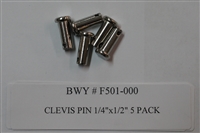
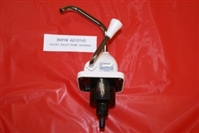
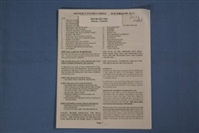
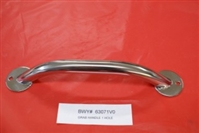


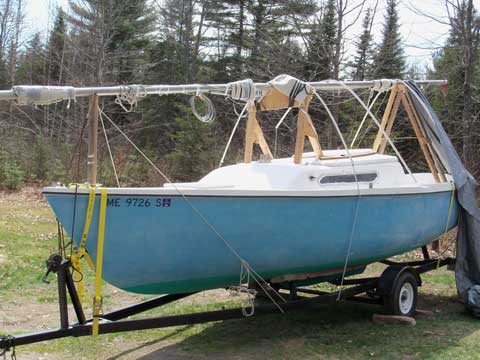



IMAGES
VIDEO
COMMENTS
Designed to determine if a boat has blue water capability. The CSF compares beam with displacement since excess beam contributes to capsize and heavy displacement reduces capsize vulnerability. The boat is better suited for ocean passages (vs coastal cruising) if the result of the calculation is 2.0 or less. The lower the better.
Venture 2-24 is a 24′ 6″ / 7.5 m monohull sailboat designed by Roger MacGregor and built by Macgregor Yacht Corp between 1971 and 1974. Great choice! Your favorites are temporarily saved for this session.
A few days ago we found a 1972 MacGregor Venture 2-24 that sails, but has a gutted interior on craigslist with a price of $1200. We went and took a look at it and ended up getting it for $1100. The hull has been repainted, main and jib sails are there and in ok shape, rebuilt swing up rudder, new v-berth support structure, and new cabinet/sink ...
A forum for discussing topics relating to older MacGregor/Venture sailboats. Forum rules. 13 posts • Page 1 of 1. Silent Partner Deckhand Posts: 41 Joined: Thu Nov 22, 2012 1:53 am ... Sailboat: Venture 2-24 Location: Western Wisconsin, USA. Re: 1974 Venture 2-24. Post by topcat0399 » Fri Nov 30, 2012 3:32 am.
9 posts · Joined 2011. #2 · Dec 5, 2011. Just looked at a Venture 2-24 today, have pics of it... I posted earlier about going to look at a 1974 Venture 2-24. Previous owner. said sails are great, rigging is great, mast is fine and keel is decent. Interior is gutted and dirty, and there are a few cosmetic blemishes here and.
The Venture 2 24 is a 24.58ft fractional sloop designed by Roger MacGregor and built in fiberglass by Macgregor Yacht Corp between 1971 and 1974. The Venture 2 24 is an ultralight sailboat which is a very high performer. It is reasonably stable / stiff and has a low righting capability if capsized. It is best suited as a day-boat.
I just picked up a macgregor venture 24 - 1972. I am hoping to fix this up and have been looking for some rigging instructions and maybe the orginal manual/handbook for this boat. If there is anyone that can help it would be appreciated. Thanks! Save Share. ... Venture 2-24 I have a 1972 Venture 2-24 and sail it in coastal Maine waters. ...
1973 24' MacGregor Venture 2-24 sailboat for sale in Inverness Florida
The 1972 MacGregor Yachts Venture 2-24 sailboat has a fiberglass hull and has an overall length of 24.58 feet (sometimes referred to as LOA). The width (or beam) of this craft is 711 inches. This boat is rigged as a Sloop. The sail area for the sailboat is 231 square feet. The displacement for the boat is approximately 2100 lbs.
Today, with some 36,000 sailboat hulls behind it, the company builds just one boat, the hybrid sailboat/powerboat MacGregor 26x. Although MacGregor sold fewer Venture 21s than its successor—the Venture 22, which later became the pop-top Venture 22-2—the 21's easy trailerability and affordable price helped it maintain its popularity ...
Sell Your Boat Used Gear for Sale. Parts. ... MacGregor Venture 2-24. Thread starter John McF; Start date Jul 27, 2004; Forums. Macgregor Owner Forums. Ask A Macgregor Owner Status Not open for further replies. J. John McF. Jul 27, 2004 #1 Anyone who can provide any suggestions for where I can purchase a upper (wire) stay for a macgregor 224? ...
ForeverDes. Registered User. Join Date: Aug 2012. Location: Indiana. Boat: New Horizons 25'. Posts: 189. MacGregor Venture 22. I have an opportunity to buy a MacGregor/Venture 22 for a very inexpensive price. I have not yet seen the boat, or any pictures, so I'm basing everything I know right now on the brief description given me by the owner.
Jul 29, 2010. 1,392. Macgregor 76 V-25 #928 Lake Mead, Nevada. Jul 3, 2014. #6. If you have the original mainsail with the original sail #, that will be the hull #. If not there should be a fore/aft stringer on the starboard side under the cockpit. The hull # is drill into that stringer. Let us know how ya make out.
1.5-6'. Maine. $3,500. Description: 24 Newport Venture fiberglass with classic lines based on English pilot cutters. Hull is in excellent condition with swing keel center board. Bowsprit of mahogany. Equipment: Low hours Yamaha 8 hp outboard mounted on a heavy duty pull up bracket.
Venture 24/224, Venture 25, MacGregor 25, 26C & 26D requires halyard to be raised 24" above headstay. See our Spinnaker Halyard Relocation Kit to raise the halyard. Part number #3807-1V4. Does not include sheets. Roller Furling / 5.0 Dacron / White UV cover.
6 sails. 2 Mainsails, original is fair to poor, current main is good with 1 set reef points, battens on leech. 4 Headsails, original 110 Genoa from fractional rig is fair and works well as a stand alone in heavy breeze. 170 Genoa with tear on luff, otherwise good. 160 Genoa is good. 150 Genoa is good and the common "go to" for her.
Macgregor/Venture, 2-24, 1973, Orono, Maine. 4/20/10, Macgregor/Venture, 2-24, 1973, Orono, Maine, $2,500, Taken off market 8/2/10 ... Texas Lakes: Advertise with us: Contact: Free Sailboat Ad: Go to Sailing Texas classifieds for current sailboats for sale . Macgregor/Venture, 2-24, 1973 General condition and any additional information: I have ...
The Venture 24 is a 24.58ft fractional sloop designed by Roger MacGregor and built in fiberglass by Macgregor Yacht Corp between 1969 and 1971. The Venture 24 is an ultralight sailboat which is a very high performer. It is reasonably stable / stiff and has a low righting capability if capsized.
1973 Macgregor Venture 2-24,1973 Venture 2-24 by MacGregor. Very nicely restored and appointed. Sleeps four, convertible dinette. ... boat, motor(15hp Johnson),And trailer with 2 new tires.Boat was totally rerigged 10 years ago. It has a mahogany electric box with all electronics individually switched, 4 life preservers, 4 throwable cushions ...
The first version was called the VENTURE 25. With relatively few changes, it became the MACGREGOR 25 (around 1980). With more than 7000 boats sold, it's one of the most popular models from this builder. Masthead Rig: I: 28.3′ J: 9.75′ P: 24.5′ E: 10.5′ Photo of Venture 25 courtesy Adam Hunt.
MacGregor Yacht Co. was founded by Roger MacGregor in 1961 as part of class project while he was an MBA student at the University of California. Located in southern California. The first boat was a small catamaran, but the product line consisted mainly of small, trailerable sailing yachts, from a 15-foot (4.6 m) catamaran to 17-foot (5.2 m) pocket cruisers, up to 26-foot water ballasted ...
Negotiable. Need gone. Boat trailer comes with. Title In hand. Make offer
The MACGREGOR 22 is similar to the VENTURE 222. Photo courtesy of Adam Hunt. Sailboat Forum. View All Topics: ... Like the LWL, it will vary with the weights of fuel, water, stores and equipment. A boat's actual draft is usually somewhat more than the original designed or advertised draft. For boats with adjustable keels (centerboards ...